The guarantee of motivation from the jurisprudential line of the Ecuadorian Constitutional Court
DOI:
https://doi.org/10.62452/ert5ty86Keywords:
Constitutional Court, jurisprudential lines, fundamental rights, guarantee of motivation, due processAbstract
The guarantee of the motivation as part of due process is tactically determined in the Constitution of the Republic of Ecuador. Through the years and thanks to the permanent control of the Constitutional Court of Ecuador on the jurisprudential processes, this guarantee has been able to evolve, achieving a unified criterion and developing the same jurisprudential line. The general aim of this work is to analyze, critically, the jurisprudential line of the Constitutional Court of Ecuador regarding the basic guarantee of motivation, from the milestone judgment to conclude in the conformation of the guiding criterion in judgment No. 1158-17-EP/21. By means of a methodological approach of qualitative research, and with the application of methods such as historical-logical, inductive, and literature review, as a result of this research work a document of critical analysis concerning the position of the Constitutional Court in terms of processes that throughout history were considered as suitable, for its jurisprudence, as well as the comprehensive approach of the motivation until it determines the sufficiency and appropriateness of the legal processes.
Downloads
References
Corte Constitucional del Ecuador. (2009). Sentencia N. 025-09-SEP-CC. http://doc.corteconstitucional.gob.ec:8080/alfresco/d/d/workspace/SpacesStore/1bc37c45-5bbd-414c-849c-1ff1ea98aff4/0023-09-EP-res.pdf
Corte Constitucional del Ecuador. (2012). Sentencia N. 227-12-SEP-CC. http://doc.corteconstitucional.gob.ec:8080/alfresco/d/d/workspace/SpacesStore/9ddb1953-2786-4758-acae-18adeac48ebf/1212-11-epsentencia.pdf?guest=true
Corte Constitucional del Ecuador. (2019). Sentencia N. 860-12-EP/19. http://doc.corteconstitucional.gob.ec:8080/alfresco/d/d/workspace/SpacesStore/99ea55f1-560a-46aa-a36c-d2be4f59d027/860-12-EP-19(0860-12-EP).pdf
Corte Constitucional del Ecuador. (2021). Caso No. 1158-17-EP. https://www.fielweb.com/App_Themes/InformacionInteres/1158-fw.pdf
Ecuador. Asamblea Nacional Constituyente. (2008). Constitución de la República del Ecuador. Registro Oficial 449. https://www.oas.org/juridico/pdfs/mesicic4_ecu_const.pdf
Ecuador. Asamblea Nacional. (2009). Ley Orgánica de Garantías Jurisdiccionales y Control Constitucional. https://vlex.ec/vid/ley-organica-garantias-jurisdiccionales-643461681
Espinosa, C. (2010). Teoría de la motivación de las resoluciones judiciales y jurisprudencia de casación y electoral. Tribunal Contencioso Electoral.
Ferrer, E., Martinez, F., & Figueroa, G. (2014). Diccionario de Derecho Procesal Constitucional y Convencional Tomo I. Instituto de Investigaciones Jurídicas.
Ferrer, E., Martinez, F., & Figueroa, G. (2014). Diccionario de Derecho Procesal Constitucional y Convencional Tomo II. Instituto de Investigaciones Jurídicas.
Hernández, V. (2018). El test de motivación de la Corte Constitucional del Ecuador: ¿Cómo conocer si una sentencia está correctamente fundamentada? YACHANA Revista Científica, 7(1), 21-31.
Organización de los Estados Americanos. (1978). Convención Americana sobre Derechos Humanos (Pacto de San José). OEA. https://www.oas.org/dil/esp/1969_Convenci%C3%B3n_Americana_sobre_Derechos_Humanos.pdf
Sarango, H. (2008). El debido proceso y el principio de motivación de las resoluciones/sentencias judiciales. (Tesis de maestría). Universidad Andina Simón Bolívar.
Tenesaca-Maldonado, S., & Trelles-Vicuña, D. (2021). El Derecho Constitucional a la Motivación: Línea Jurisprudencial de la Corte Constitucional, a partir del año 2019. Ciencias económicas y Empresariales, 6(1), 246-267.
Downloads
Published
Issue
Section
License
Copyright (c) 2023 Angel Patricio Bustamante-Fajardo, Victoria Molina-Torres (Autor/a)

This work is licensed under a Creative Commons Attribution-NonCommercial-ShareAlike 4.0 International License.
Authors who publish in Revista Metropolitana de Ciencias Aplicadas (REMCA), agree to the following terms:
1. Copyright
Authors retain unrestricted copyright to their work. Authors grant the journal the right of first publication. To this end, they assign the journal non-exclusive exploitation rights (reproduction, distribution, public communication, and transformation). Authors may enter into additional agreements for the non-exclusive distribution of the version of the work published in the journal, provided that acknowledgment of its initial publication in this journal is given.
© The authors.
2. License
The articles are published in the journal under the Creative Commons Attribution-NonCommercial-ShareAlike 4.0 International License (CC BY-NC-SA 4.0). The terms can be found at: https://creativecommons.org/licenses/by-nc-sa/4.0/deed.en
This license allows:
- Sharing: Copying and redistributing the material in any medium or format.
- Adapting: Remixing, transforming, and building upon the material.
Under the following terms:
- Attribution: You must give appropriate credit, provide a link to the license, and indicate if any changes were made. You may do this in any reasonable manner, but not in any way that suggests the licensor endorses or sponsors your use.
- NonCommercial: You may not use the material for commercial purposes.
- ShareAlike: If you remix, transform, or build upon the material, you must distribute your creation under the same license as the original work.
There are no additional restrictions. You may not apply legal terms or technological measures that legally restrict others from doing anything the license permits.




